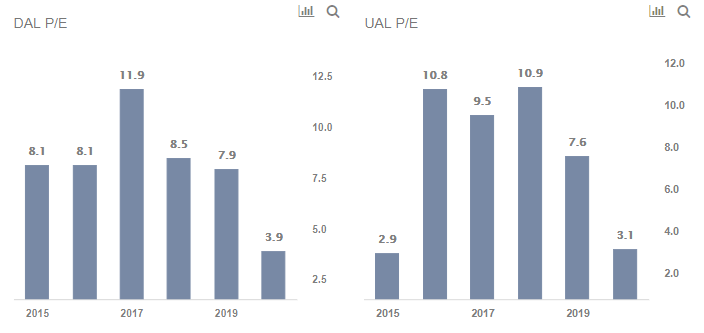Riskier Airline Stock: United or Delta?
United Airlines’ stock (NASDAQ: UAL) has gained 40% since the market fell to the lows in March, while the shares of Delta Airlines (NYSE: DAL) have recovered 30%. Passenger demand fell by almost 90% in Q2 as stay-at-home orders and social distancing measures restricted population movement across cities in-order to contain the spread of the coronavirus. While passenger numbers at TSA checkpoints have observed a slight uptick after the easing of restrictions by various states, a prolonged slump in demand remains a concern for the deeply battered industry. Available cash and curtailing cash burn rate have been the key focus for all air carriers in recent months but, we believe that United Airlines’ stock faces a higher downside risk than Delta primarily due to its higher cash burn rate, lower operating margin, and less cash on the balance sheet.
We compare trends in key metrics for the two airline companies over the years to compare their relative valuations under the current circumstances in our detailed dashboard analysis, Is Delta Air Lines Expensive Or Cheap vs. United Airlines Holdings?
Why Is United A Riskier Bet Than Delta?
- Spurred By Stellar Earnings, Can United Airlines Holdings Stock Extend Its Run?
- United Airlines Holdings Stock Looks Set For A Come Back
- Down 13% Last Week, Can United Airlines Holdings Stock Bounce Back?
- Is United Airlines Stock On The Move?
- Company Of The Day: United Airlines
- Will United Airlines Stock Rise After Recent Correction?
United and Delta are the biggest commercial airlines in the U.S. with comparable revenues. In 2019, United and Delta reported 1,372 and 1,062 aircraft in their fleet, respectively. While both companies have observed a slow-growth in revenues in the last five years, United Airlines’ lower operating margin is expected to keep its cash burn rate elevated despite the company’s target to achieve $30 million per day by September. Daily cash burn rate refers to cash from operations excluding the impact of proceeds under the CARES Act. Per recent filings, Delta reported a daily cash burn rate of $27 million for June and expects to further reduce it in Q3.
Thus, United’s P/E based on 2019 earnings has declined from over 7.6x in 2019 to 3.1x currently, while Delta’s multiple has declined from 7.9x to about 3.9x. The steeper decline in United’s multiple can also be attributed to its failed bond issue in May and a recent credit rating downgrade. Also, Delta already has $15 billion of cash reserve on its balance sheet which can support the $27 million of daily cash burn for 19 months. On the flip side, United has recently raised $6.8 billion in debt secured by its loyalty program and plans to achieve $17 billion in liquidity by September.
Recovery in travel demand hinges on an effective coronavirus treatment or a successful vaccine. Our Coronavirus Vaccine Portfolio and Coronavirus Treatment Portfolio highlights the performance of key stocks in the respective fields.
See all Trefis Price Estimates and Download Trefis Data here
What’s behind Trefis? See How It’s Powering New Collaboration and What-Ifs For CFOs and Finance Teams | Product, R&D, and Marketing Teams

